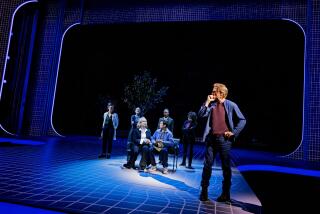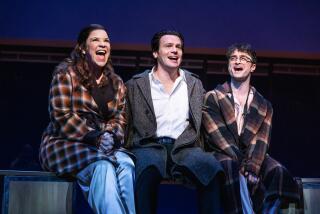Edward Albee: Part-time pussycat
- Share via
Edward Albee, without question our nation’s greatest living playwright, lives just the way you might expect him to -- in a rarefied artistic ozone that feels completely at home to him.
African sculptures and 20th century European and American paintings proliferate in his TriBeCa loft like wildflowers on a sunny hillside. An elevator opens directly to the apartment, where a flirty feline named Abigail, a part Abyssinian acrobat, insists on making friends before allowing entry into this heightened realm, in which a Kandinsky and a Chagall stare each other down, a little Picasso etching lurks on a back table, and alarming masks and seemingly animate artifacts track your every move.
Famously fussy about language, Albee prefers to call himself an “accumulator” rather than “a collector,” though there’s nothing random about the objects in his private gallery. Asked what the display might say about his aesthetic, he dryly answers, after a meditative beat, that he “knows what he’s doing.” He lightly shoos away the notion of a connection with his playwriting, but the truth is probably closer to what he told his biographer Mel Gussow: “Art should expand the boundaries of the form and, simultaneously, it should change our perceptions. I despise restful art.”
Chances are, when he takes the stage of Royce Hall on Saturday for “An Evening With Edward Albee,” a UCLA Live event that’s intended to draw out his thoughts on “the power of the arts as a catalyst for change,” this senior statesman of American drama will dismantle, with his usual take-no-prisoners precision, the received wisdom and shopworn pieties that are always obscuring what pure artists like himself are attempting to do.
Still trim and vigorous at 80 (a hearing aid is perhaps his one visible concession to aging), Albee has a reputation for not suffering fools gladly. As someone who has seen him clip the verbally woolly wings of interviewers, I approached the privilege of meeting him on his home turf with a fair amount of trepidation. And despite having corrected people in the past on the pronunciation of his name -- it’s Awl-bee, not Al-bee -- I misspoke soon after greeting him, and the error was gently though promptly pointed out.
But this master of invective -- the man who set the theatrical world ablaze in 1962 with the emasculating marital crossfire of “Who’s Afraid of Virginia Woolf?” -- is, well, no offense to Abigail, something of a pussycat in person.
“I’m very nice until I’m crossed,” Albee says with a calm courtliness. “I only get really annoyed when the situation demands it. But then my response is less anger than couth. Anger diminishes your ability to be objective. Frank O’Hara wrote a poem titled ‘In Memory of My Feelings,’ and that is essentially what writers are doing when they write.”
Rialto lore has painted Albee as quite a tyrannical overseer of his work, and he admits that he can be a “control freak.” “I insist that people do every line of the play that I have written,” he says. “I have approval of my actors and my director. And design also, because I want people to see the play that I wrote. I’d rather it stand and fall on what I did than on what somebody else did.”
Given the intense roller-coaster ride he’s had with the critics over the years, it’s no wonder he feels the need to maintain a tight grip. But something in him softens when he reflects on the great talents who have brought his characters to life. And it’s those luminaries who are no longer with us -- Peggy Ashcroft, John Gielgud and Uta Hagen -- who spring immediately to mind.
Of course, the old Zeus fire returns when he recalls, without naming names, the three actors he “would never work with again.” With a faint smirk, he adds, “Unfortunately, they all keep working, though I’m glad to see one’s career is going down fast.”
Albee has a penchant for pungent truth-telling. In some respects, he’s a more sober version of Claire, the illusion-puncturing alcoholic in his 1966 play “A Delicate Balance,” who can’t help remarking, while gazing at family members writhing in their protracted existential crises, “that there are so many martyrdoms here.”
But one shouldn’t give short shrift to the Albee who’s a passionate advocate of the arts, a mentor to younger dramatists and a social commentator with an incisive gift for dispelling fog. And now, after Harold Pinter’s passing in December, he is one of the last of the English-language playwrights to have attained a level of cultural standing that has transcended the parameters of theater.
“I liked Harold a lot,” Albee says. “I liked his politics, I liked his work, and I also liked that he admired Sam Beckett as much as I did.”
Does he think it possible for the new generation of writers to achieve what Pinter and he managed to accomplish through their plays? “It’s more and more difficult for a playwright to make any noise,” he says. “Serious, complex work isn’t encouraged.” Still, he thinks the best people will continue to emerge. “No one should be a playwright and expect to get as rich as a screenplay writer. But then the work is going to be an awful lot better because most screenplays are written by hacks. Or good people who are turned into hacks to finance the movies.”
Although he’s dismayed by the empty-headed “commercialism” of the American theater, Albee doesn’t want to see playwrights turning themselves into reformers or, worse, reporters. “I’m always suspicious of journalistic responses to specific issues.” The piece that was probably most inspired by a public event, he says, was his 1960 drama “The Death of Bessie Smith,” but his approach has generally been “to hold the mirror up to people and say, ‘This is the way you’re behaving. If you don’t like what you see, change.’ ”
This Chekhovian strategy fits his artistic temperament, but in everyday life he’s all for playwrights responding to social injustice and political malfeasance. “One thing I didn’t understand was why nobody protested that we had a coup d’état with this latest Bush,” he says. On a happier topic, he’s impressed by President Obama and confesses that he has “nonintellectual feelings” about the maturity of the country to have elected a black man.
What’s interesting to note is that even when Albee’s emotions are visibly engaged, he exhibits an astonishing capacity for cool computation. The shapeliness of his sentences seems to be immune to pique or pity. “I’d like to think that I can be more objective than a lot of people can,” he says. “I think my objectivity began very early as an orphan. Being adopted, I didn’t have the feeling that most kids have, that these were the people who made me. That sense of familial obligation wasn’t clouding up my responses to them.”
Albee had a famously turbulent relationship with his adoptive mother, whom he wrote about in his 1994 drama “Three Tall Women.” When asked if he found the experience cathartic, he says he “doesn’t know that he needed psychological help” but that he was pleased to hear from people who knew her that his depiction was in fact “nicer than she actually was.”
Resentment, in his view, can only get in the way of dramatic truth, which he’s still actively pursuing with the same vigor of the young man who wrote “The Zoo Story,” the play that nearly half a century ago introduced his distinctly voiced themes of alienation, sexual confusion and the self-deception implicit in social life. (Albee says he has two new dramas in the works, and a New York production of “Me, Myself & I,” which premiered last year at the McCarter Theatre in Princeton, N.J., is still being discussed.)
A zoo and a sandbox
“The Zoo Story” remains as fresh as ever, but interestingly, it’s “The Sandbox,” another early play first done in 1960, that Albee says is the only one in which he “didn’t make any mistakes.” Puckishly, he adds, “But then it’s hard to make mistakes in 12 minutes. If the play would have gone on another 40 seconds, I probably would have screwed up.”
He acknowledges that the figure of a lost or stolen baby crops up with noteworthy frequency in his work. But not in the mood for a Freudian frolic, and with Abigail receiving steady caresses from him, he’d prefer to talk about the prevalence of animals in his plays. “There’s an extraordinary connection there,” he says, itemizing the cats, dogs, lizards and even one hussy of a goat that have populated his stylized yet somehow completely natural dramatic landscapes.
Satisfied that he raised the subject, he diverts his attention to the four-legged creature leaping and pouncing with delightful abandon in this highbrow romper room of eclectic masterpieces.
More to Read
The biggest entertainment stories
Get our big stories about Hollywood, film, television, music, arts, culture and more right in your inbox as soon as they publish.
You may occasionally receive promotional content from the Los Angeles Times.










